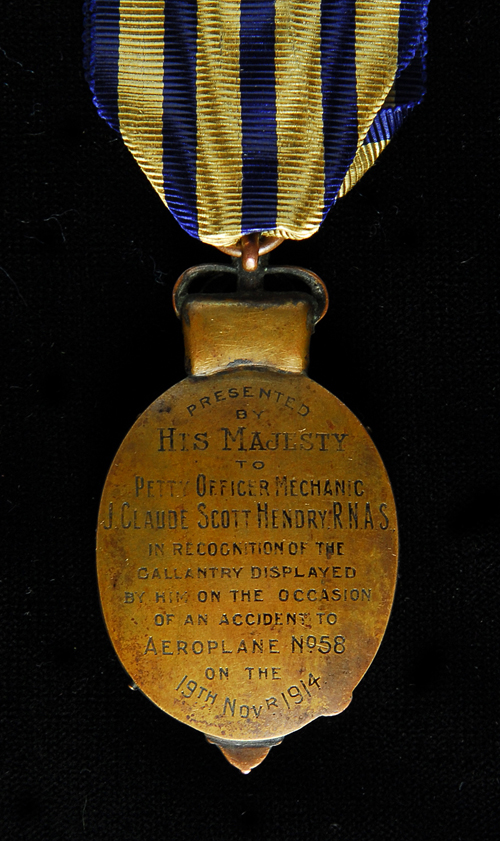
Auction: 7029 - Orders, Decorations, Medals & Militaria
Lot: 359
A Scarce and Early Great War R.N.A.S. Albert Medal to Petty Officer Mechanic, Later Second Lieutenant (Observer) J.C.S. Hendry, Royal Naval Air Service and Royal Air Force, Who Displayed Gallantry on Three Separate Occasions in the Rescue of Life at Sea, 1914, Including on One Occasion After He Had Fallen 150 Feet From His Aircraft into The Winter Seas; He Was Later Reported as Killed in Action Whilst Acting as an Observer on an Anti-Submarine Patrol in the Channel, 6.7.1918 Albert Medal, 2nd Class, for Gallantry in Saving Life at Sea, bronze and enamel, obverse lacking central monogram, the reverse officially engraved, ´Presented By His Majesty To Petty Officer Mechanic J. Claude Scott Hendry. R.N.A.S., In Recognition of the Gallantry Displayed by Him on the Occasion of an Accident to Aeroplane No. 58 on the 19th Novr. 1914.´, otherwise very fine Estimate £ 2,000-2,500 A.M. London Gazette no trace. James Claude Scott Hendry, Petty Officer Mechanic, Royal Naval Air Service (Seaplane School, Calshot) PRO file HO45/10772/276085, the citation is taken from the HRO file, ´´March 11, 1914. Helped pilot with both in water clinging to wreckage of seaplane. July 28, 1914. Assembly Flight at Spithead, only with great difficulty could he be persuaded to share with the pilot one float of seaplane left undamaged by enforced descent. Early morning November 19, 1914, north of Yarmouth as Observer and Operator piloted by Flt. Lt. Ian Davis. Machine capsized by premature explosion of a bomb dropped by the pilot who was stunned by the explosion. Hendry was thrown out and fell some 150 ft. into the sea, Davis fell in plane. In spite of the fall in winter time Hendry at once swam to the pilot and released him, a very difficult and dangerous undertaking for the machine was rapidly sinking and the officer was imprisoned under water unconscious and drowning, at the risk of being entangled in the wreckage and dragged to the bottom. He swam directly to a trawler and left her boat to pick up Davis who was kept afloat by the air in his clothing. He then directed the trawler to proceed and moor alongside Crossley Hospital.´´ ´´Almost every award can be verified from the London Gazette..... but the bronze medals awarded to Chief Stoker J. Sullivan, R.N. (27th August 1913), Petty Officer J.C.S. Hendry, R.N.A.S. (15th April 1915) and Mechanician F.G. Marshall (13th May 1915) do not seem to have been gazetted, although the dates of authorisation given here are those appearing in the Navy List. The citations for all three are given by Wilson and McEwen´´ (British Gallantry Awards, P.E. Abbot and J.M.A. Tamplin, refers). Royal Mint records show all three awards as having been ordered and supplied, with Hendry´´s medal having been approved by His Majesty the King 15.4.1915. Second Lieutenant James Claude Scott, A.M. (1887-1918), born Kilmarnock, Scotland; joined the Royal Navy as Boy 2nd Class, 25.9.1905; served during the Great War as ´´Petty Officer Telegraphist R.N. attached Staff C.in.C. the Nore. Since joining R.N.A.S. [has done] Instructional and Experimental work at Eastchurch C.F.S. and Cranwell´´ (service papers refers); advanced Temporary Warrant Officer 2nd Class, 7.5.1917; posted R.A.F. Station Isle of Scilly, 24.9.1917; commissioned Second Lieutenant (Observer) Royal Air Force, 1.4.1918; reported missing in action and later listed as killed in action 6.7.1918, when in Short 184 N2963 (piloted by Lieutenant C.W. Capes) on an anti-submarine patrol (English Channel), he is buried in Guilvinec Communal Cemetery, France, the only Commonwealth War Grave in the cemetery.
Sold for
£4,600




